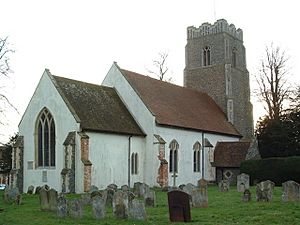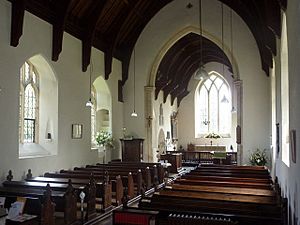All Saints' Church, Brandeston facts for kids
Quick facts for kids Church of All Saints, Brandeston |
|
|---|---|
 |
|
| Location | Brandeston, Suffolk, IP13 7AQ |
| Country | England |
| Denomination | Church of England |
| History | |
| Status | Active |
| Architecture | |
| Functional status | Parish church |
| Heritage designation | Grade I listed |
| Administration | |
| Parish | Brandeston |
| Deanery | Loes Deanery |
| Archdeaconry | Archdeaconry of Suffolk |
| Diocese | Diocese of St Edmundsbury and Ipswich |
The Church of All Saints is a historic parish church in the village of Brandeston, Suffolk, England. This beautiful church was built during the Middle Ages and is part of the Church of England.
Because of its great age and importance, it is protected as a Grade I listed building. This is the highest possible rating for a historic building in England.
History of the Church
The Church of All Saints has stood for hundreds of years. The oldest parts of the church were built in the 14th century. The chancel, which is the area around the altar, was built in the early 1300s. The tall stone tower was added later in the same century.
On December 7, 1966, the church was officially recognized for its historical and architectural value by being made a Grade I listed building.
A Look Inside All Saints'
The inside of the church is filled with interesting historical features. One of the most notable items is a font made from Purbeck marble, a special type of limestone from Dorset that can be polished like a gem. This kind of font is common in old churches in this part of Suffolk.
You can also see many memorials dedicated to the Revett family, who were important in the church's history. The church also has beautiful pieces of medieval stained glass. One piece shows a picture of Saint Catherine, while others show a monk and a person who likely helped pay for the window.
A Time of Great Trouble
During the 16th and 17th centuries, England experienced a lot of conflict over religious beliefs. The country was moving toward a new form of Christianity called Puritanism, but some people wanted to keep older traditions.
John Lowes was the vicar, or priest, of All Saints' Church for over 40 years, starting in 1596. He tried to blend older Catholic-style rituals with the new rules of the Church of England. This made him unpopular with those who wanted stricter, simpler services.
This was also a time of great fear and superstition. A man named Matthew Hopkins, who called himself the Witchfinder General, traveled the country accusing people of witchcraft. In 1645, he accused Reverend Lowes. Sadly, Reverend Lowes was found guilty and was executed in Bury St Edmunds, along with 39 other innocent people.
This dark chapter in history was shown in the 1968 movie Witchfinder General, starring the famous actor Vincent Price.


